Content warning: article contains discussions of incest, sadism, and torture porn. Spoiler warning for the movie Brimstone.
Brimstone is the latest victim of the Grimdark plague afflicting too many narratives nowadays. To the point that I’ve started accidentally calling the movie “Grimstone” or “Brimdark”. Dakota Fanning is convincing in the lead role of a traumatized, hunted survivor, but no amount of good acting can redeem such an unpleasant, painfully long (nearly 2.5 hours) and pointlessly sadistic ordeal. Not even Kit Harington’s somewhat brief appearance and sad puppy face is worth it.
The Road to Hell is Paved with Faux-Feminist Tales of Empowerment™
For some reason that still escapes me, the Political Film Society (whatever that is) has nominated Brimstone as “best film on human rights of 2017”. They have praised director-screenwriter Martin Koolhoven for daring to expose the “extreme debasement of women” in a the mid-19th century American West, while making a jaw-dropping political comment,
“Another theme is the depiction of the American West as lawless, hinting that within American culture there is an extraordinary macho strain that continues in family life and politics, what Theodore Adorno called the ‘authoritarian personality,’ which maintains strict discipline at home and votes for those who appear strong enough to break the rules to get things done. Brimstone was released at a time when filmviewers may find resonance in the story with the rise of Donald Trump to the presidency.”
Sure, it’s easy to connect “the rise of Donald Trump” to misogyny (it’s also lazy and simplistic). The problem is that Brimstone is not actually exposing or denouncing it; it’s actively participating in constructing it. Depicting the “extreme debasement of women” (the wording used by the Political Film Society should already give you a clue) in an exploitive, pornified, Grimdark framework reminiscent of Justine, or the Misfortunes of Virtue is not the way to bring attention to misogyny, rape culture, or violence against women. It brings us back to the old debate of Depiction vs. Endorsement which is actually way older than we might think.
Before diving headfirst into the disturbing, depressing universe of Brimstone, I propose a short trip into the historical origins of the Grimdark subgenre. This topic deserves its own piece, which will be fully fleshed out in the future, but let’s start with a quick overview.
Gothic vs. Grimdark and the Sadean Narrative
Unlike David Benioff and Dan Weiss (D&D), the infamous (around here) showrunners of Game of Thrones, Brimstone director Martin Koolhoven at least never pretended he was writing a Dramatically Satisfying™ “Gothic Horror,” though it does contain similar tropes. Indeed, it’s hard not to compare the two. So much so I had to pause while watching Brimstone to check if they shared a screenwriter or ‘creative genius’ in common rather than just Kit Harington and Carice van Houten (they don’t seem to).
As a historian of the French Revolution and the 18th century, it’s also difficult not to see the similarities between the Grimdark narrative to which Benioff, Weiss, and Koolhoven subscribe and Sade’s Justine, or the Misfortunes of Virtue. Especially when the former attempt to root their stories in “historical accuracy” or “historical realism.”
Some of the main themes of the Gothic genre are impossible to separate from the historical era in which it originates. Like most fiction, the eternal battle between Good and Evil is at the forefront. In this case, the concepts most commonly used during the period were those of Virtue and Vice, in which the Apostles of Vice try to tempt, lure or corrupt the Champions of Virtue.
Gothic fiction is further characterized by decay and corruption, which parallel that of the Ancien Régime itself. The old protectors (nobility) and moral guardians (clergy) were the institutions that used to champion Virtue. However, by the 18th century, they are increasingly failing in their duties; they were no longer capable of playing and fulfilling their roles, or deliberately stood against them, leading to the rise of new “Champions of Virtue.” These new heroes will define the 19th century with new struggles. In this period, the revolutionary acts as a substitute for the fallen figure of the “Knight in Shining Armor” and “Protector of the Innocent.”
As a moral and political critique of the Ancien Régime, Gothic fiction shares much in common with epistolary novels of that century, but they both differ from Sade in significant ways. Most importantly, in the former Virtue ultimately triumphs. Sure, it won’t get out of the fight unscathed. Its champion will lose their innocence; they might fall from grace, they may even die, often by sacrificing themselves, but what they represent will endure.
The same holds true of contemporary Gothic fiction. Even the Hannibal series, which seemingly showcases a perfect Sadean villain (he even plays the harpsichord, come on!), is not Sadean itself. Despite the temptation, corruption, and fall of the hero, Virtue still prevails and triumphs (beautifully, I must say).
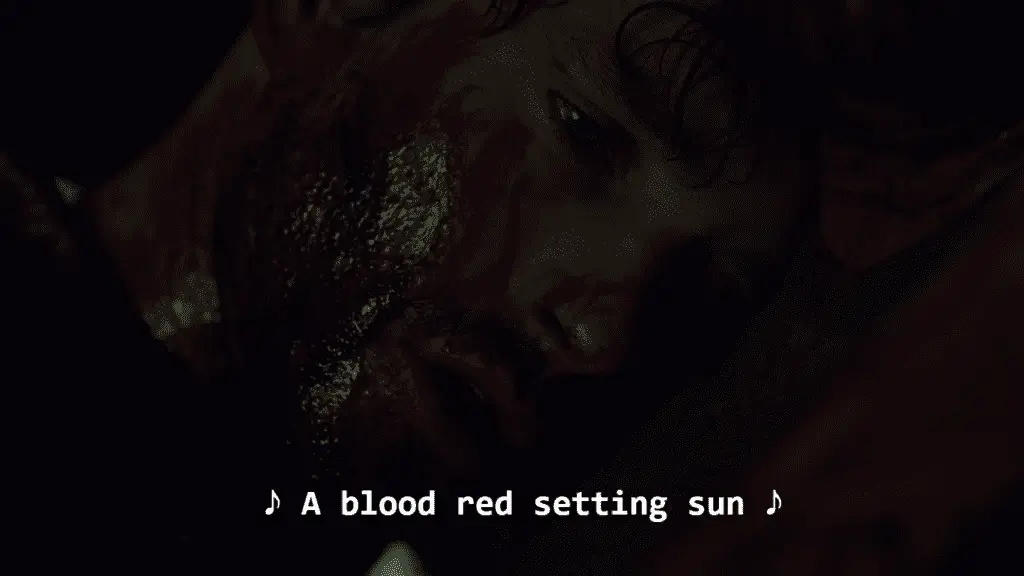
As “Love Crime” (the song playing during this moment) says it best, the characters embodying this thematic struggle play an ageless “deadly game”, on which depends the meaning not just of good and evil, but of life and humanity.
This narrative, however, bores a certain type of people who long to see ‘the villains win for a change’, who wish the world was shown as it ‘truly, realistically, accurately is’—from their point of view—in all its gritty darkness and villainy. One of these was the Marquis de Sade (that’s the first and last time I will dignify him of his title and particle).
Over the course of his career, Sade brought forward arguments extremely similar to the usual apologetic discourse excusing the Grimdark turn in storytelling. Like history as the true source of atrocities and the necessity to depict evil in the most horrifying (and graphic) ways to make sure that evil is understood and loathed as such.
In the preface to his 1791 edition of Justine, he bragged about his “originality” in inserting a plot twist that had “undoubtedly” never been done before: letting the villains win and rewarding them in the narrative while the Champions of Virtue remain forever miserable and meet atrocity after atrocity.
“The scheme of this novel (less a novel than one might suppose) is undoubtedly new; the victory gained by Virtue over Vice, the rewarding of good, the punishment of evil, such is the usual scheme in every other work of this type: shouldn’t we be tired of such a hackneyed lesson!”
In other words, it’s boring when the Good Guys win, especially if they don’t face horrific circumstances to make us appreciate their (seemingly vain) struggle.
The 1791 edition pretended to be a moralistic cautionary tale—and a “most sublime” one at that, as he praises it himself—destined to make people, especially women, “love Virtue more” by making her champion “suffer beautifully and sublimely.” Sade’s 1799 re-edition (La Nouvelle Justine) featured even more exploitation, more torture, more rape, and more murder. His intentions had taken a much darker turn.
By 1799, his sarcastic praise of Virtue had vanished. Virtue is now a “ridiculous idol” worshiped by “imbeciles” who fail to realize they will never be rewarded for their good deeds. It’s better to “abandon oneself to Vice than to resist it,” because “Virtue is too weak to fight against Vice” and choosing her side is a sure way to lose. For these reasons, he proclaims he must “courageously dare” to depict crime as it is, “that is, always triumphant and sublime, always happy and fortunate”, while virtue is “always dour and always sad, always pedantic and always miserable.”
Sade was also a troll, both in history and literature. On July 3, 1789, when tensions were already high, he screamed from his cell in the Bastille that prisoners were being butchered and that people needed to come and free him. (It wasn’t true – and the revolutionaries who later stormed the prison were disappointed to find out there were only seven prisoners inside). He also trolled the philosophical themes of the Enlightenment and the Revolutionary politics, parodying them, twisting them, and pushing them to absurd limits.
Sade weaponized irony and ambiguity in a way that wouldn’t seem out of place on 4chan (coughs). His prose is nauseating, yet inevitably boring. Even in the 18th century Shock and Awe™ got old pretty fast. His style ripped off other pornographic novels of the century, like Thérèse Philosophe (1748), in which porn was intercut with philosophical ramblings. Only for Sade, his blandly described, repetitive “porn” was made of rape, abuse, torture, and murder, while the “philosophy” provided “natural” justifications for these.
In short, Sade created his own Grimdark “satire” of Gothic horror in which he corrupted the roles of the main characters. The protagonist/Champion of Virtue, often an Ingénue (usually female but sometimes male), becomes a Doom Magnet bringing death and disaster everywhere they go. The calamities that befall the protagonist extend to every good person who has the misfortune to cross their path, befriend them, or want to help them. Nothing can save them, not even Providence/God is on their side. Their belief in goodness, honor, and virtuous principles is mocked, and they are punished for holding onto them.
Meanwhile the villain who, as in Gothic fiction, is often a Depraved Aristocrat or a Corrupt Priest or Nun becomes an overpowered Villain Sue, deflects karma, and is rewarded for understanding the ‘truth’ about ‘human nature’. This is the Sadean Narrative.
Sound familiar?
Sade’s excuses and defenses are the same as D&D’s: invoking historical accuracy, realism, human nature, ‘how things really are or were’, etc. But that’s bullshit. It’s a construction. As much as they pride themselves in showing the so-called truth of human nature, Grimdark writers and their apologists neglect whole parts of it, omit them, erase them in order to create, as Adam Roberts puts it, a cynical, nihilistic, ultraviolent world “where nobody is honorable and Might is Right”.
The same can be said of Martin Koolhoven’s Brimstone.
Brimstone, or the Misfortunes of Virtue
This 149 minute long movie is divided in four chapters: “Revelation,” “Exodus,” “Genesis,” and “Retribution”. The second and third chapters are out-of-order flashbacks explaining how we got here while the last chapter resumes where we left off in the first.
In the first chapter, we meet Liz (Dakota Fanning), who’s mute. She works as the town’s midwife. She’s happily married with two kids, a stepson and a daughter. Everything is going mostly well. However, her past catches up on her when she meets the town’s new reverend. As we’ll later learn, Liz’s real name is Joanna, and the new reverend she’s terrified of isn’t just a sadistic, hypocritical asshole who’s been chasing her for a while, he’s also her incestuous father. The main purpose of the nonlinear narrative serves to conceal this plot twist (somewhat predictable when you know the genre though YMMV).
The chronological beginning of the story is in “Genesis”, in which young Joanna (Emilia Jones) is 13 years old. On the night Joanna menstruates for the first time, she finds her father, the Evil Reverend (Guy Pearce), whipping her mother, Anna (Carice van Houten), in the barn for not putting out. It’s filmed in a voyeuristic, creepy way that hides behind the excuse of “exposing violence against women” to showcase torture porn. This is one of the many pointlessly graphic whipping scenes featured in the movie, another of which involves a child actress who was less than ten years old at the time of filming (Ivy George, who plays Sam, Joanna/Liz’s daughter).
Anna finds out her husband is creeping on their daughter, because “now she’s a woman” and her mother is not fulfilling “her wifely duties.” Presumably to stop her from telling everyone (I assume because it’s never explained), the Evil Reverend gets her a scold’s bridle. It’s ridiculous but hey, it does provide great imagery for the trailer and for the reviews to denounce the “extreme debasement of women.”
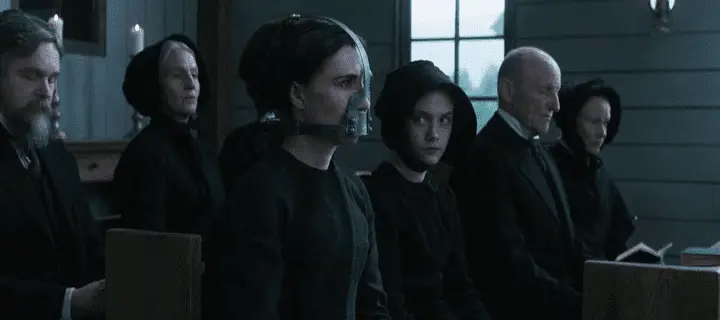
It doesn’t get any better from there on out.
Goodness Gets You Killed
Get used to this basic rule when watching the movie: each nice person dies horribly. Because goodness gets you killed. Because it’s written that way.
- Anna, Joanna’s mother who could have protected her – hangs herself.
- Johnny Sand, who tried to save her – shot with his own gun (through the Reverend).
- Nice Sex Worker Sally – hanged for murder.
- Random Mourning Father – shot in a rigged duel he could never have won.
- Nice Friend Elizabeth – stabbed with her own knife (through the Reverend).
- Nice Husband Eli – disemboweled (by the Reverend).
- Protective Teenage Stepson Matthew who tried his best to protect his Stepmom and Half-Sister – shot (by the Reverend).
- Nice Husband’s Father (and Mathew and Sam’s Grandpa) who was helping Joanna and Sam by hiding them – impaled to a door (by the Reverend).
The anvil needs to be dropped about what kind of world Justine, I mean, Joanna, lives in. It’s a Crapsack World from which there is no escape, as the rest of the movie will painfully remind Joanna (and the viewer) each time a spark of hope shines through.
Soon after the Evil Reverend gets the scold’s bridle for his wife, for example, Joanna asks her mother why she lets him treat her that way, and that she would rather die than live like that. This scene leads directly to Anna wandering off and immediately hanging herself right there in the church while her husband is preaching about how evil women are. Awkward. One of the few (maybe even only) people who could have protected Joanna is now dead.
Similarly, the whole subplot involving Kit Harington is ultimately insignificant and only serves to reinforce the lesson that good deeds will lead you to your grave. He’s a Thief With a Heart of Gold who wanders onto the Evil Reverend’s ranch, and Joanna hides him in the barn until he recovers from his wounds. He’s a Good Guy; he turns her down when she reluctantly offers herself to him. Johnny Sand (let’s just call him that) is the only one to oppose the Evil Reverend when he decides to marry his own daughter. He’s even all backlit with glorious sunlight, like a Prince Charming finally showing up!

Just as he’s about to shoot the Evil Reverend, he somehow loses grasp on his own gun —SOMEHOW—and the Reverend shoots him instead. Bye Johnny Sand. You tried. You just couldn’t win in this kind of narrative.
After her “wedding” to her father, Joanna runs away to the desert, where she faints, is found, and is ultimately sold to a brothel, Frank’s Inferno. Most of the women she meets are Mean and Catty and mock the 13 year-old child, except for one Nice Sex Worker named Sally who protects the last shreds of Joanna’s innocence. Needless to say, she meets a dire end; she’s hanged by the sheriff for murdering a man who wanted to rape Joanna. Even though she was just defending herself, as Joanna tearfully insists, Frank reminds her “there are rules,” and Sally knew not to defy them.
Several years later, the now grown-up Joanna (played by Dakota Fanning) witnesses a duel between Frank and a mourning father, who blames the former for his daughter’s death and demands a “fair fight.” Joanna, her friend Elizabeth, and all the other women working at Frank’s Inferno cheer for this unnamed man, an unlikely Champion of Virtue in this Crapsack World. He symbolizes The Good Father None Of Those Women Presumably Had:
“It’s men like you, who think their actions have no consequences, who are making this country turn into what it’s turning to. So, for my daughter’s sake, for every daughter’s sake, I have to kill you.”
Much like Johnny Sand earlier, he dies. The duel was rigged anyway so he could never have won. Cue the sad faces of the women who needed another reminder of the world they live in.
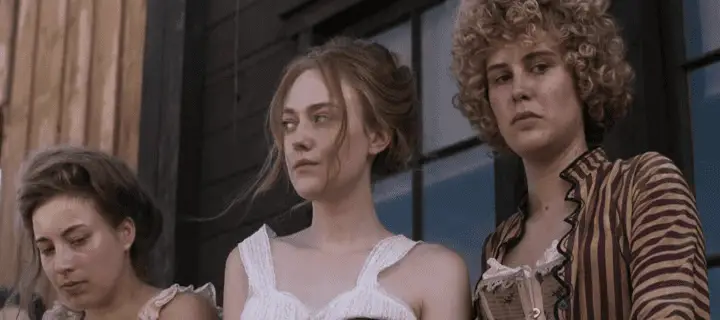
But one of the most over-the-top example of this disturbing ‘theme’ is the murder of Joanna/Liz’s stepson, probably punished because he wanted to become a nice person someday. The scene is utterly ridiculous. There’s a blizzard, you can’t see a thing, and yet the Evil Reverend manages to shoot the kid? Who only got out of the wagon because he accidentally dropped his own riffle? Why did any of this have to happen? Because it provides great imagery, I guess.

So, to recap: Joanna/Liz’s life sucks. Anybody who tries to save her, protect her, rescue her, or cares about her dies violently. Narrative Acedia strikes again.
The only decent person who makes it out alive is the doctor who refuses to cut out Joanna’s tongue when she comes up with the illogical plan of taking Elizabeth’s place.
Meanwhile, the Evil Reverend is near unkillable. Cut his throat and let him to drown in his own blood in a room you set on fire? He survives that! (The movie never really explains how, nor stops to ponder how impossible this would be even with the best medical care the 19th century could offer.) Set him on fire? He feels nothing apparently, he even seems to embrace it, either because he made a pact with the devil (which I would be willing to accept at this point) or because he’s a Secret Targ. Who the hell knows? Well, Hell might actually know. Liz/Joanna does shoot him out the window, but she should have made sure he was really dead, because he might be Michael Myers’s ancestor.
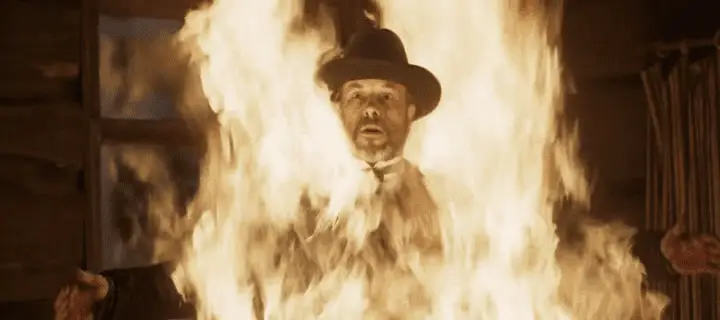
Not only does he have exaggerated physical strength—despite his age and job, I mean, he’s not a soldier, he’s a reverend—and can snipe a kid in a blizzard with a mid-19th century weapon (could this even be done?), he seemingly has magical powers or future technology allowing him to consistently find where Joanna is. Did he microchip her? Does he have a GPS? Just how small is the Old West exactly? How does he keep finding her?
It’s a very small world, mostly because it’s written that way, a way that makes no logical sense whatsoever once you stop and think about it for a minute.
In Which the Movie Falls Apart
Besides torture porn, Brimstone has several problems both in regards to its construction and plot. Mostly that it makes no sense. The nonlinear narrative, which seemed interesting at first, does a very good job at concealing this important fact.
When we first meet Liz, she’s mute because her tongue was cut out. How did this happen?
We learn this in the second chapter, “Exodus”, when Joanna takes her dead friend’s identity. Elizabeth was a Nice Friend, so of course this means something bad would inevitably happen to her. In a scene of very gratuitous violence, Frank cuts off her tongue because she bit a customer’s tongue who was trying to kiss her while she had repeatedly told him not to.
The local doctor checks her up and gives her a book on sign language, which she learns along with Joanna. It’s sweet. Liz wants to run, and finds a Nice Older Man (see where I’m going with this?) who lost his wife and doesn’t care about her past, as long as she can cook and doesn’t mind that he already has a son from a previous union. Liz is very excited, and asks Joanna to come with her, and they can pretend to be sisters. Again, it’s kinda cute.

But of course, this nice ending just cannot be. (BECAUSE IT’S WRITTEN THAT WAY.)
On the very evening they plan to run away, they get the visit of a Very Special Customer who pays every woman in the brothel, and Frank is adamant that no matter what he wants, you give it to him. Guess who it is?
Why, it’s the Evil Reverend of course!
He came to find Joanna and is Very Disappointed by “her life choices”—namely, being sold to a brothel—and decides he has to “punish her”. This sentence is said so many times throughout the movie I’m sure it’s only there for a specific part of the audience to masturbate to. But hey, ‘Human Rights’ amirite?!
Elizabeth hears Joanna’s screams and rushes to save her. As you recall, however, she does not survive the confrontation with the Reverend (she’s too nice), yet he somehow manages to survive both having his throat cut and being set on fire. And this is where the shaky foundations the movie is built on finally collapse.
Joanna should be free. She thinks her father is dead. (And he should be, even though he’s not.) The brothel is on fire. She could go wherever she wants, do whatever she wants. But, instead of, I don’t know, doing something that doesn’t involve cutting her own tongue out, she decides to take Liz’s place and identity. Since ‘her’ husband-to-be expects a woman without a tongue, she visits the doctor and asks him to cut out her tongue. He can’t bring himself to do it, so she does it herself.
I can’t stress enough how pointless and gratuitous this is, or how this makes no sense in any kind of reality. There was no reason for her to do that. She didn’t have to take Liz’s place. She didn’t have to cut out her tongue. But that wouldn’t be as Dramatically Satisfying, now would it?
The Voiceless, or Missing the Point of Themes and Metaphors
Brimstone completely fails to grasp any actual theme or metaphor present in the story (besides, maybe, the “Symbolic Blood on the Snow” shot, whatever that meant).
The typical excuse of “historical accuracy” to depict “reality” in all its grittiness mysteriously disappears once it comes to one of the main traits of the protagonist: her being mute because she has no tongue. The addition of that disability to the story is never really explored, neither metaphorically nor realistically. Brimstone treats a self-inflicted disability as a Shock and Awe moment, and then erases its meanings from the narrative, much like Jaime Lannister and Theon Greyjoy in Game of Thrones.
Other than a brief moment with the doctor telling the original Liz how to care for her wound and giving her a book of sign language, and one scene in which Elizabeth teaches Joanna what she learned, the subject is thrown away so fast it almost feels anachronistic. It seems so random and out of place, it’s hard to believe that sign language has a very old, very rich, very interesting history because the movie treats it like a footnote.
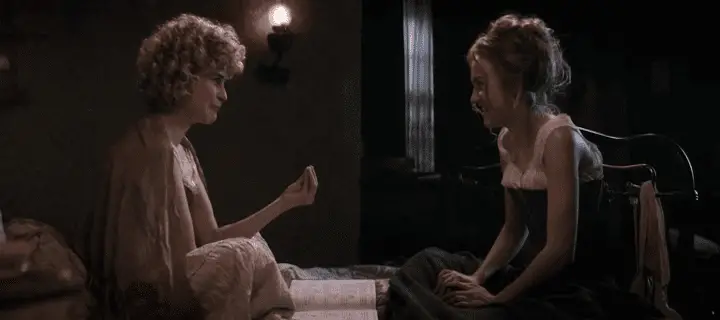
Brimstone alsο completely erases any struggle Liz/Joanna might have with her disability while living in the 19th century Old West; it never stresses how dangerous and potentially deadly it would be to cut your own tongue. Which, I might reiterate, was only done to fulfill the plot’s contrived demands. She never has any communication problems. It never actually impacts the narrative. It doesn’t seem to incapacitate her at all. The only reason it happens is so the film can remind us (again) this is a Crapsack World, and she/we just can’t have nice things.
Speaking of the ending, it’s the final cherry on top of the ‘life is crap and good people can’t be happy’ cake. A sheriff from the town where she worked in the brothel drops by, and we learn the original Elizabeth had murdered Frank just before ‘rescuing’ Joanna from the Evil Reverend. As Joanna claimed her identity, she is now guilty of her crime. Conveniently, her daughter (who had been her interpreter) is nowhere to translate for her, but she doesn’t even attempt to explain anything. There’s nothing to explain, really. As the sheriff who comes to arrest her puts it:
“You should’ve changed your name, Liz. How many Elizabeth Brundys you figure there are in this world? And how many of ‘em you figure don’t got no tongue?”
Life sucks.
The sheriff wants to bring her back to the town to hang her and puts her on a boat. In one final act of agency (maybe), Joanna, who is cuffed with heavy chains, decides to throw herself into the river, and drowns. But it’s ok! We see her smiling underwater.
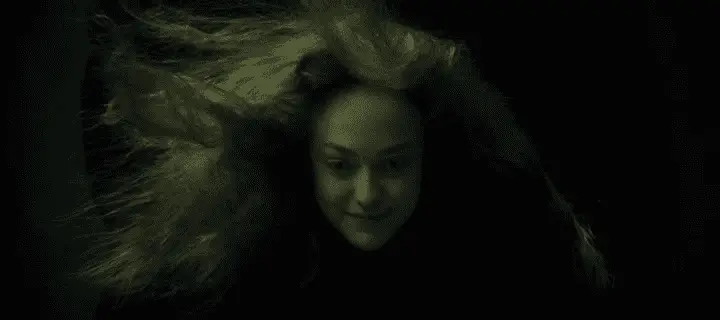
As this depressing epilogue unfolds, we hear the voice of a narrator, much like we had in the opening of the movie. We realize it was provided by a grown-up Sam. “I remember her well,” she says in the end. “She was a warrior. Always in control.” Well, except from the part where her entire story was controlled by men, including first and foremost by the director-screenwriter.
Life Isn’t Sadistic, The Writer Is
This is a movie that tackles a faux-feminist message yet fails to grasp the meaning in a woman cutting off her own tongue. Martin Koolhoven seemingly has no idea what genre he’s writing, borrowing tropes from Gothic horror, Grimdark edginess, exploitation movies, and slasher films. This would be sad, if he wasn’t so smug, somehow believing he’s the first director-screenwriter to ever tell a Western from ‘a woman’s point of view,’
“Koolhoven: So I decided to started (sic) writing one, and then I started thinking, What is it actually that I’m interested in here? Why is it such an interesting genre? There’s this almost boyish quality to it, this adventure and artistic idea of freedom. But then, as I was thinking that, I thought, that’s a very macho approach. It’s only a half-truth because for women, Westerns are not actually about freedom all. I had just read a book called In the Rogue Blood by James Carlos Blake about two brothers, and at some point, the sister runs away and they say, “Okay, what are her options? Either she’s going to marry someone or she’s going to be a prostitute.” And that sort of hit me. I realized that that side of the story is never really told. There’s not a lot of movies about that. Actually, none at all. Then I thought there has to be a movie from that point of view.”
Even if we ignore the many different female-lead Westerns that showcase a great diversity of roles for women, Koolhoven isn’t even the first to tell a story from a sex worker’s perspective; I found a film with four of them.
Though it’s rather simplistically true that, historically, women have more often than not been confined to make a choice between “being a wife or a prostitute,” there were still many ways to navigate and test these limits. Exceptions don’t make the rule, but they still exist. So let’s ignore how there’s a 1993 movie that proves Koolhoven wrong. And the fact that the Old West was a lot queerer than we think.
Nah, let’s just remake Justine, or the Misfortunes of Virtue, set it in the Old West and call it Brimstone. How Bold!
Koolhoven and some interviewers seem to think Brimstone is doing something new, and praise it as “daring” and “provocative”. It’s not. Nothing here is new. This story is old, really old. This has been done already, over and over and over. There are ways to tell the story of a girl then young woman who tries to escape from her abusive father. Brimstone was obviously not the way to do it. Unfortunately, this form of storytelling is in vogue, much like the Grimdark subgenre itself.
At the end of the day, Brimstone is the same old Grimdark exploitation nonsense, the misogynistic, nihilistic, and reductive roots of which go all the way back to Sade. Horror and cruelty do exist, yes, but you can choose how to write about it. You can choose what you show on screen versus what you describe with dialogue. Sometimes “Show, Don’t Tell” doesn’t (shouldn’t) apply. As such, it’s rather easy to tell when the purpose is… well, torture porn.
The existence of evil doesn’t negate the reality of goodness. “Realness” and “historical accuracy” don’t equal “sadistic.” Writers who choose to depict these stories this way and inflict it on us, however, are.

